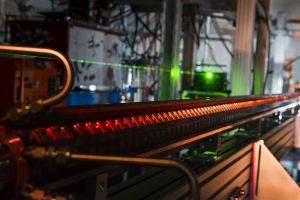
Ultra-compact accelerators for science and medical research
-
Source:
Content translation using original press release in German.
- Date: November 2018
-
Ultra-compact accelerators for science and medical research
Helmholtz Association sponsors project for accelerator technologies "ATHENA" with almost 30 million euros
Developing novel, compact particle accelerators for applications in science and medical research is the goal of the new accelerator technology research and development platform "Accelerator Technology HElmholtz iNfrAstructure" (ATHENA). The platform is a collaboration of six Helmholtz centers, including the Karlsruhe Institute of Technology (KIT). The Helmholtz Association is funding the project as a strategic expansion project with 29.99 million euros.

The linear accelerator FLUTE is an example of the compact and flexible accelerator systems at KIT. (Photo: Markus Breig, KIT) The largest and best-known particle accelerator in the world, the 27-kilometer Large Hadron Collider (LHC), is located at CERN in Switzerland. With LHC, scientists are researching the structure of matter. In addition to their outstanding importance for basic physical research accelerators open up numerous other applications, from production technology to medical use, for example in tumor therapy or diagnostics. However, today's accelerator systems are costly in construction and operation. If powerful accelerators were significantly smaller, this technology could be used much more frequently. The aim of the research at KIT is therefore also to enable the first technological applications of ultra-compact accelerator systems in the life and material sciences. KIT receives funds of 4.5 million euros from the new research and development platform for accelerator technologies ATHENA. KIT President Professor Holger Hanselka pointed out that for the scientists in Karlsruhe, ATHENA provides access to plasma-based accelerators (see reference Press Release in German). This fits perfectly with accelerator research at KIT, which aims to develop accelerator technology on a broad basis for society.
In particular, the storage of ultra-short electron packets in a specially designed electron storage ring is an outstanding application of this new technology, said the leading accelerator physicist at KIT, Professor Anke-Susanne Müller. This allows increasing the usable light pulse rates by a factor of one million for applications of terahertz radiation in medicine and materials science. In addition, this procedure saves energy, as stored electrons can be used for a longer time. "In the field of diagnostics of accelerator signals with high repetition rates, we regularly extend the limits of what is physically and technologically feasible and already today support our partners in the Helmholtz Association and, in the future, within ATHENA with our technologies," adds Dr. Erik Bründermann, project manager of the ATHENA subproject at KIT.
The linear accelerator FLUTE (see photo), which was put into operation in July 2017 in Karlsruhe, is an example of the compact and flexible accelerator systems at KIT. Within the ATHENA project the acceleration length should reduce even further and could shrink to the size of a few centimeters in the future.
Coordinated by the Deutsches Elektronen-Synchrotron (DESY), the Helmholtz centers involved in ATHENA also will set up two German lighthouse projects based on innovative plasma-based particle accelerators and state-of-the-art laser technology: DESY in Hamburg, electron accelerator facility and Helmholtz-Zentrum Dresden-Rossendorf (HZDR ), hadron accelerator facility. Both facilities are to be used to develop a variety of applications, ranging from a compact free-electron laser (FEL) through innovative medical applications to new applications in particle physics. As soon as technologies and plasma accelerators are ready for use, new, compact accelerators could be deployed and set up in other Helmholtz centers, but also at universities and hospitals.
The six centers of the Helmholtz Association involved in this accelerator project include, besides KIT, DESY and HZDR, the Forschungszentrum Jülich, the Helmholtz-Zentrum Berlin, the GSI Helmholtzzentrum für Schwerionenforschung in Darmstadt and the Helmholtz-Institut Jena.
The ATHENA activities are closely integrated into the European research landscape through the EU-funded design study EuPRAXIA with its 40 partner institutes, also coordinated by DESY. Thus, the German cutting-edge research project ATHENA also has a clear European perspective and orientation right from the start.
Source: Press Release in German
